Paula Rego - life drawing
I've long admired Paula Rego's work. Especially her pastel drawings.
Rego's work appears in the Tate Britain exhibition 'All Too Human' on until 28 August 2018
- a show that "celebrates the painters in Britain who strove to represent human figures, their relationships and surroundings in the most intimate of ways."
3 pastel drawings from Rego's Dog Women series:
 |
| 'Dog Woman' 1994 |
 |
| Sleeper |
 |
| Grooming |
She discusses when she began to life draw, what meaning it has to have - usually a narrative context, her experience of life drawing classes at art college, and favourite models - then and now.
 |
| Depression V 2006-07 |
 |
| Jenufa - pastel on paper 1995 |
"When I was nine I did a drawing of my grandmother. It was my first life drawing. She was sitting there sewing – she didn’t know I was drawing her. It looked like her.
...When I was a little older, I’d draw my cousin, Manuela – sitting, standing, or in her knickers. She’s younger than me so I could boss her around. And I drew the maids. They stood still for me. I always made a noise when I drew, a moaning, groaning sound I wasn’t aware of...
At art school – the Slade in London – we had to draw every day. We had a men’s life room and a women’s. In the women’s, the male models had to wear a cache-sex to hide their willies. We had nude female models, though. I was astonished at first but it was good training. One of the women wore slippers with bells on, so we could hear her coming. I liked her very much. She had red hair. I still have my picture of her. It was difficult getting the drawings right: we had anatomy lessons and went to a hospital to draw from bones and skulls.
We were taught what was called the Euston Road method, where you had to measure everything by eye and mark the distances with crosses as you went along. I wasn’t very good at it. My husband, Victor Willing, who was a fellow student, didn’t bother. He’d just put the crosses in afterwards. He would help me, pointing out how the arm had flat sections depending on how it was posed. For a while, I’d lift a pencil in front of the sitter to gauge distances, but now I never do. I copy what I see.
I’m not interested in painting nudes for their own sake, unless that’s part of the story. For me, the point of doing a picture is the subject matter, and I discover what that is by doing the work."
 |
| Mist II 1996 |


Comments
Post a Comment